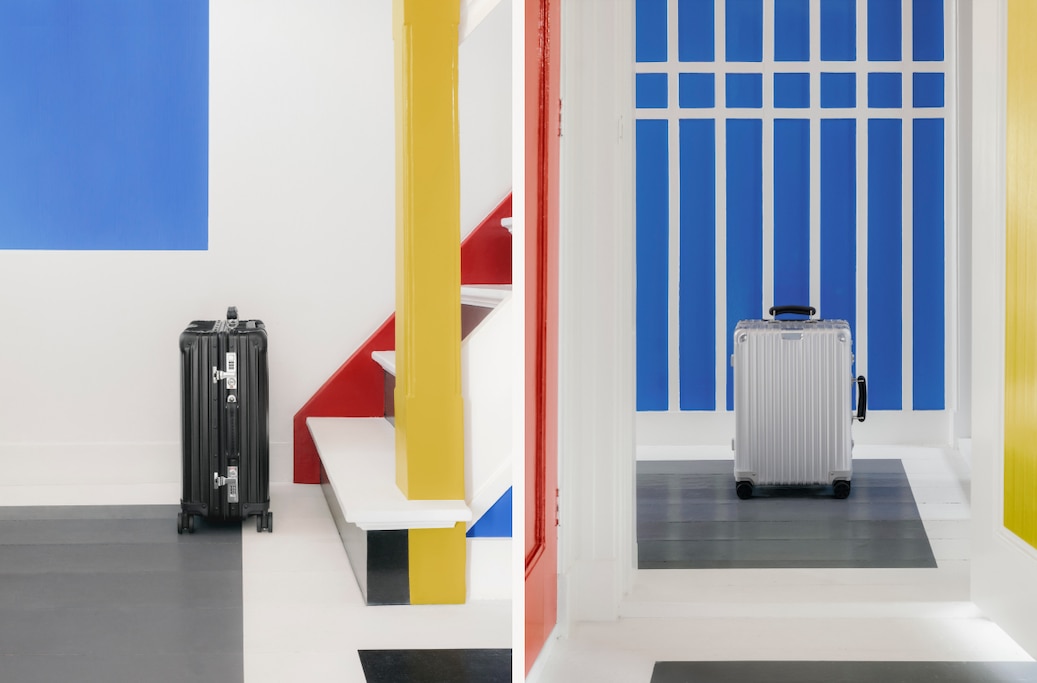Your Shopping bag
YOU MIGHT ALSO LIKE
Accessorise your RIMOWA with stickers, luggage tags and more.
Total (0 items)
£0.00
Be advised that changing your location will remove the contents from your bag.
Asterisk, Unfortunately, we do not currently offer online shopping in these locations.
Meaning ‘style’ in Dutch, ‘De Stijl’ was founded in 1917 by a group of Dutch abstract artists led by Theo Van Doesburg and Piet Mondrian, and was a movement centered on a strict geometric approach. It was characterised by the use of horizontal and vertical lines, and often featured primary colours alongside black, white, and grey, creating a distinct and harmonious visual language. The style is instantly recognisable, and is often reproduced even today.
It was also the name of a journal that acted as a vehicle for Mondrian’s ideas on art – and was the first to coin the term neo-plasticism. Following Art Deco, it is often described as a reaction against the decorative excesses of the period. This idea of ‘new art’ became the name for the type of abstract art that the De Stijl circle practised.


Discover the Distinct collection
For one neighbourhood in the Dutch city of Drachten, this abstract art form is not just recognisable, but inescapable. In 1921, the writer Evert Rinsema offered Van Doesburg the chance to produce a colour scheme for a new residential project. In line with the principles of De Stijl, Van Doesburg applied the primary colours of red, blue and yellow to the doorways and window frames along the street. Against the black, white and grey, the bright hues are nothing short of eye-catching and earned the houses the name 'Papegaaienbuurt' or, ‘Parrot District’.


Discover the Classic collection
The Van Doesburg Rinsema House now serves as a museum, meticulously restored inside and out to reflect its original 1920s appearance. This restoration was guided by in-depth historical and architectural research, ensuring authenticity in every detail. Van Doesburg’s distinctive interior features wallpaper with geometric grey planes, each carefully framed by crisp white borders, creating a striking visual effect. The museum also showcases faithful reproductions o furniture designed by Thijs Rinsema, Evert Rinsema’s brother. His De Stijl-inspired pieces bear a strong resemblance to the iconic work of Gerrit Rietveld, further immersing visitors in the artistic movement that shaped the house’s unique aesthetic.
At its heart, De Stijl has a vision for the ideal fusion of form and function – therefore appropriating the idea of ‘ultimate style’ as its very name. For this reason, it remains an inspiring movement for RIMOWA designs.
I- INSIDE THE ICONIC HAUS KEMPER
II- INSIDE HEXENHAUS, GERMANY'S HIDDEN ARCHITECTURAL GEM
IV- INSIDE JOZEF SCHELLEKENS HOUSE - A MODERNIST TOUR DE FORCE
V - INSIDE KISHO KUROKAWA'S METABOLIST CAPSULE HOUSE K
VI - INSIDE MANITOGA, A MASTERPLAY BETWEEN NATURE AND MODERNISM
VII - INSIDE SONNEVELD HOUSE: ROTTERDAM’S MASTERPIECE OF FUNCTIONALIST DESIGN
VIII - RIMOWA VISITS PIERRE PETIT’S MAISON
IX - RIMOWA visits Van Doesburg-Rinsema House